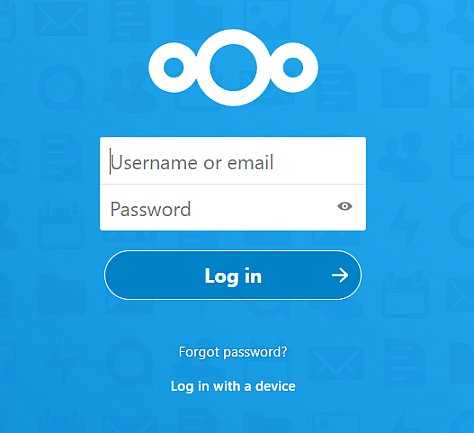Adding NextCloud for Media Previews
5 minute read.
Last Modified 2022-09-01 17:14 -0400NextCloud is a drop-in replacement for many popular cloud services, including file sharing, calendar, groupware and more. One of its more common uses for the home environment is serving as a media backup, and organizing and sharing service. This procedure demonstrates how to set up NextCloud on TrueNAS SCALE, and configure it to support hosting a wider variety of media file previews, including High Efficiency Image Fromat (HEIC), MP4 and MOV files. The instructions in this article apply to SCALE 22.02.3 and later.
Before using SCALE to install the NextCloud application you need to configure TrueNAS SCALE storage for NextCloud application to use. You also use the SCALE Shell to set the ffmpg binary before you begin the NextCloud installation and configuration.
Set up an account with NextCloud if you don’t already have one.
In this procedure you:
-
Add the storage NextCloud uses
-
Set up the ffmpg binary
-
Install the NextCloud app in SCALE
NextCloud needs a primary dataset for the application, and four datasets it uses for the primary data volume, a postgres data volume (db) and one as a postgres backup volume (dbbackup), and an one for extra mount path volume (opt).
You can either create these datasets under an existing dataset you use for applications (apps), or if you have enough disks on your TrueNAS system and want to create a new pool to use just for media files, create a new pool and then add the NextCloud datasets as child datasets to the root dataset.
To create a new pool, go to Storage and click Create Pool to add a new pool.
To add under an existing dataset, click the for the dataset where you want to add the NextCloud datasets, and then select Add Dataset. In our Nextcloud example we use pool tank, parent dataset apps* and then created the *nextcloud* dataset.
Next, select the nextcloud dataset, click and select Add Dataset to add a child dataset. Enter data in Name and click Save. Repeat this step three more times to add the three child datasets to the nextcloud dataset, one named db, the next dbbackup, and then finally opt.
When finished you should have the nextcloud parent dataset with four child datasets under it. Our example paths are:
- /mnt/tank/apps/nextcloud/data
- /mnt/tank/apps/nextcloud/db
- /mnt/tank/apps/nextcloud/dbbackup
- /mnt/tank/apps/nextcloud/opt
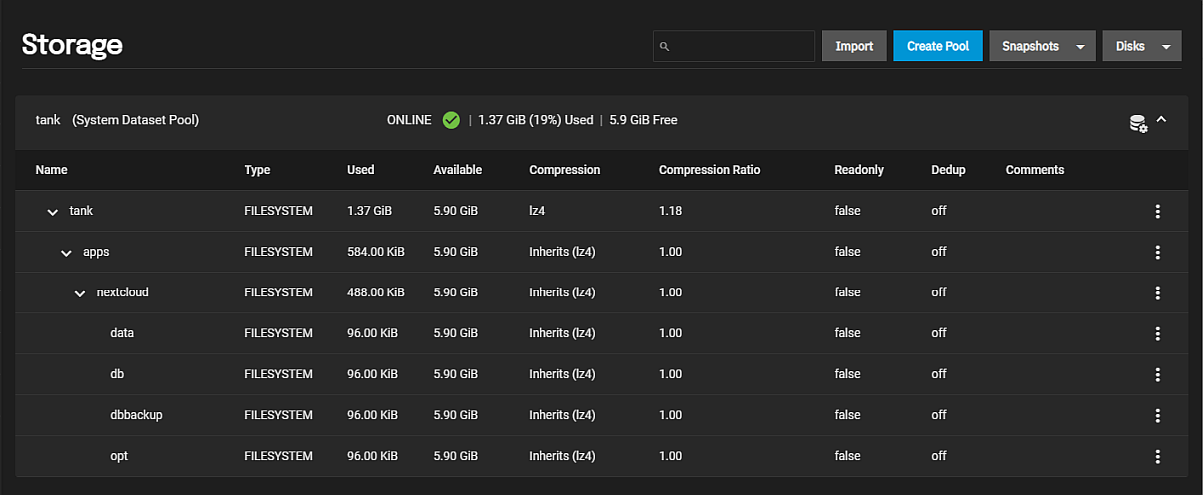
Go to System > Shell and enter these six commands:
cd /mnt/tank/apps/nextcloud/opt
wget https://johnvansickle.com/ffmpeg/releases/ffmpeg-release-amd64-static.tar.xz
tar xvf ffmpeg-release-amd64-static.tar.xz --wildcards \*static/ffmpeg
rm ffmpeg-release-amd64-static.tar.xz
mv ffmpeg-*-static/ bin/
chown root:root bin/ffmpeg
With the ffmpeg binary set you can now install NextCloud on your TrueNAS SCALE.
Go to Apps to open the Applications screen and then click on the Available Applications tab.
-
Set the pool SCALE applications use.
If you have not installed an application yet, SCALE opens the Choose a pool for Apps dialog. Select the pool where you created the NextCloud datasets from the Pools dropdown list and then click Choose to set the pool for all applications.
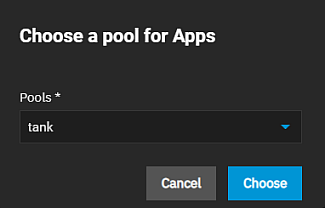
After SCALE finishes configuring the system to use this pool, a confirmation dialog displays. Click Close
-
Locate the nextcloud widget and then click Install to open the Nextcloud configuration wizard.
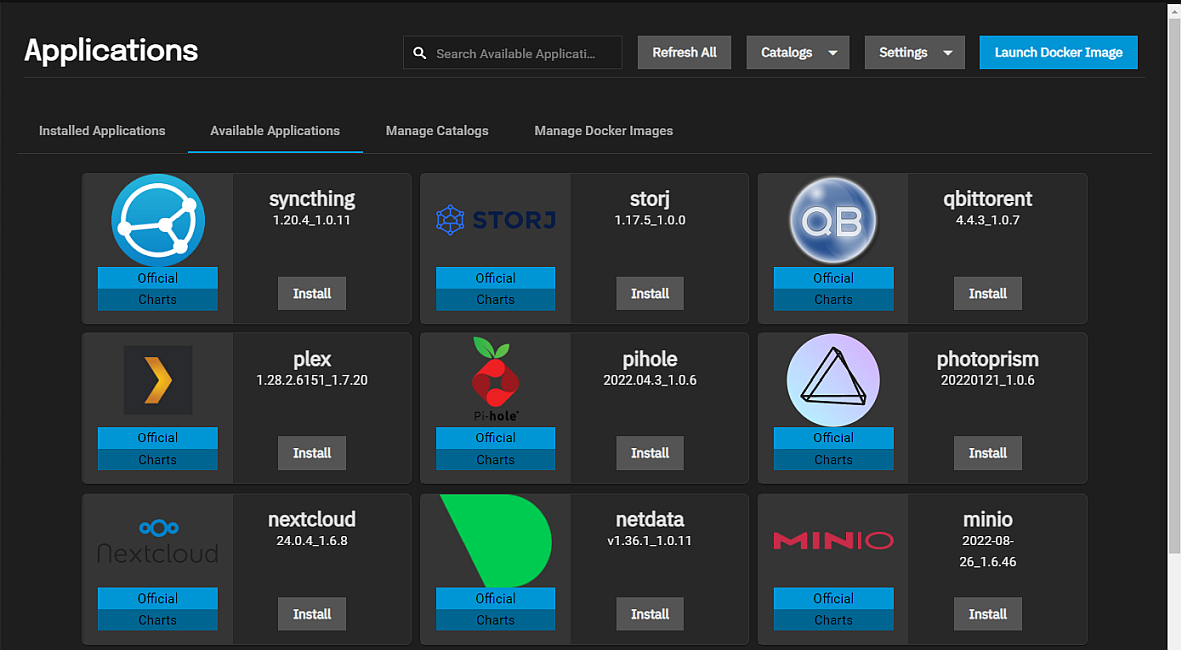
-
Enter a name for the app in Application Name and then click Next. This example uses nextcloud.
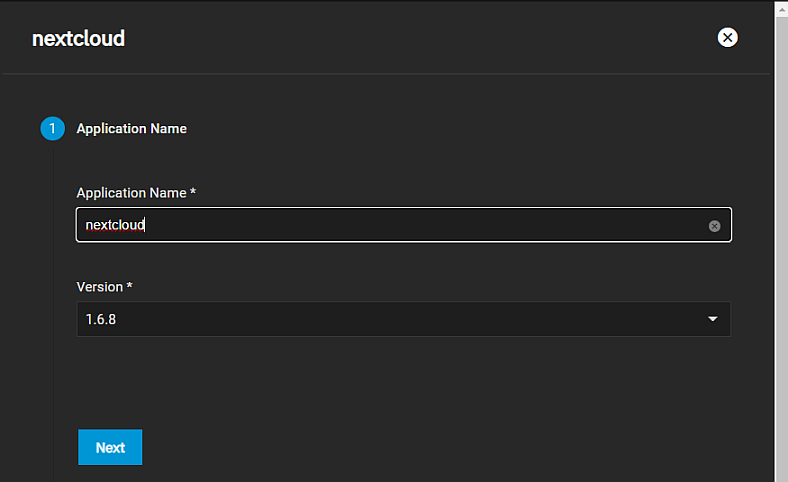
-
Enter a user name and password to use as a NextCloud login on the Nextcloud Configuration settings screen, and then click Next. For a basic installation you can leave the default values in all settings except Username and Password. This example uses admin as the user. TrueNAS populates Nextcloud host with the IP address for your server, Nextcloud data directory with the correct path, and Node Port to use for Nextcloud with the correct port number.
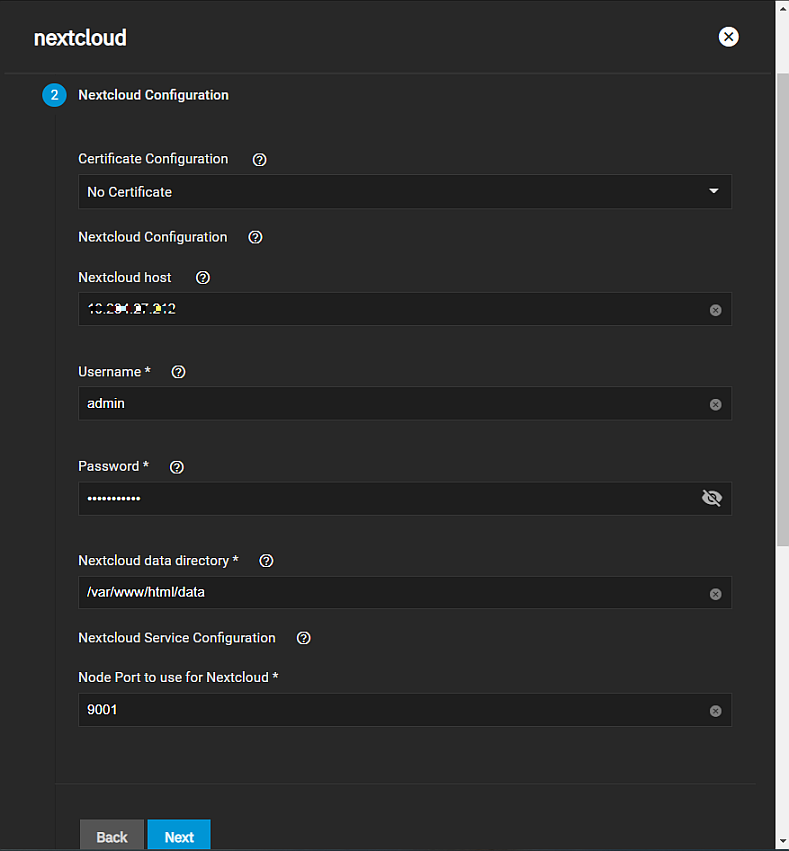
-
Enter the storage settings for each of the four datasets created for NextCloud.
Enter or browse to the location where you created the nextcloud/data dataset in Host Path for Nextcloud Data Volume. This example uses the /mnt/tank/apps**/nextcloud/data*** path.
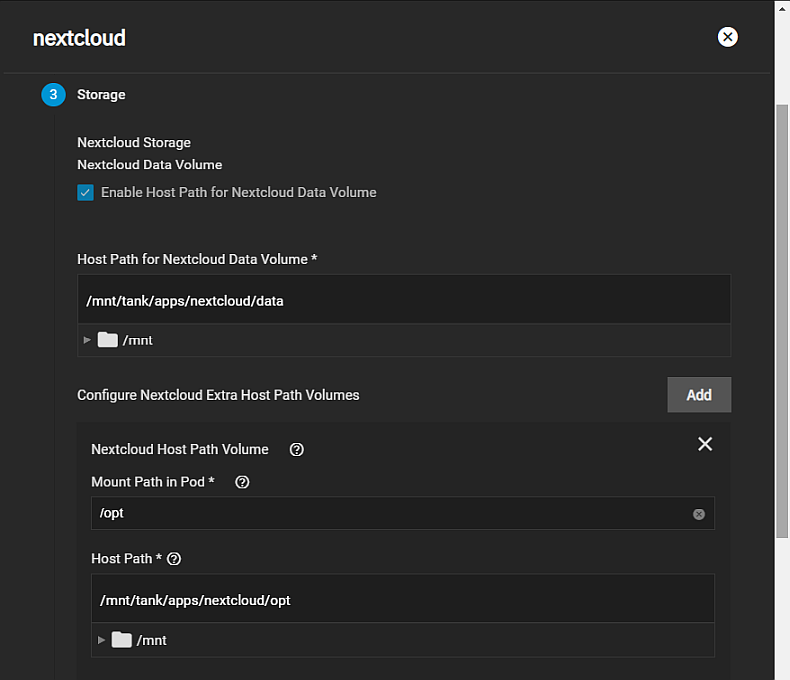
Click Add to display the Mount Path in Pod and Host Path fields. Enter /opt in Mount Path in Pod, and then either enter or browse to the location where you created the nextcloud/opt dataset in Host Path. This example uses the /mnt/tank/apps**/nextcloud/opt*** path.
Select Enable Host Path for Postgres Data Volume, and then enter or browse to the location where you created the nextcloud/db dataset in Host Path for Postgres Data Volume.
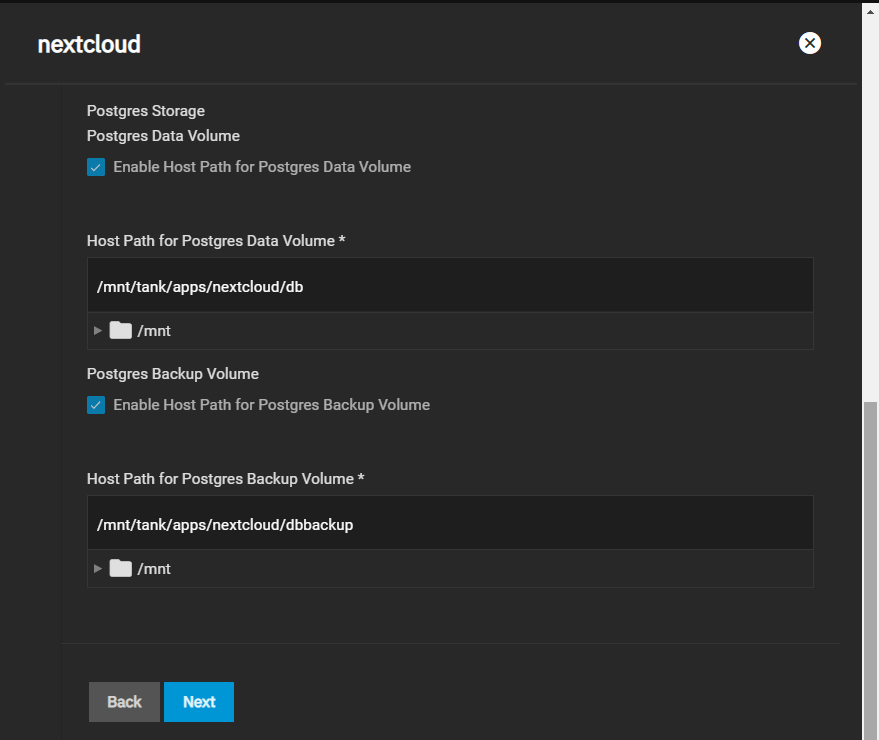
Select Enable Host Path for Postgres Backup Volume, and then enter or browse to the location where you created the nextcloud/dbbackup dataset in the Host Path for Progres Backup Volume. This completes the storage setup for NextCloud. Click Next.
-
Select Enable cronjobs for nextcloud on the CronJob configuration screen, and then click Next.
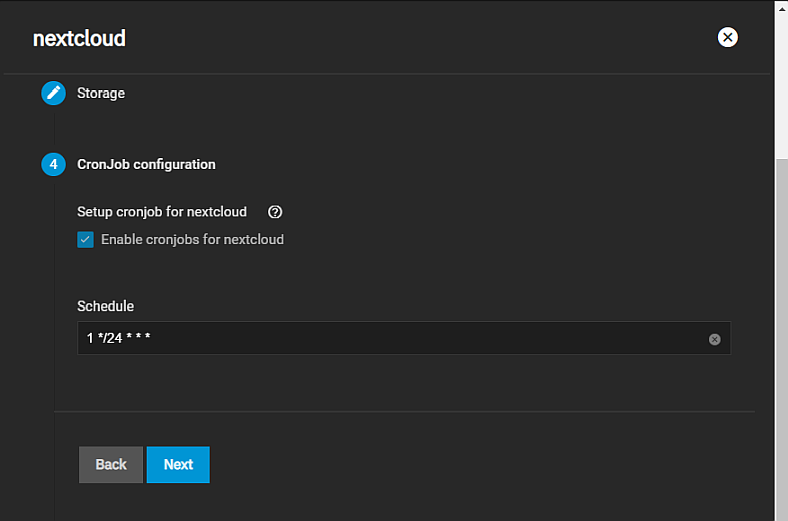
-
Accept the remaining setting defaults and click Next on the Scaling/Upgrade Policy and Advanced DNS Settings screens.
-
Review the configuration settings and then click Back to fix any errors or Save to complete the installation.
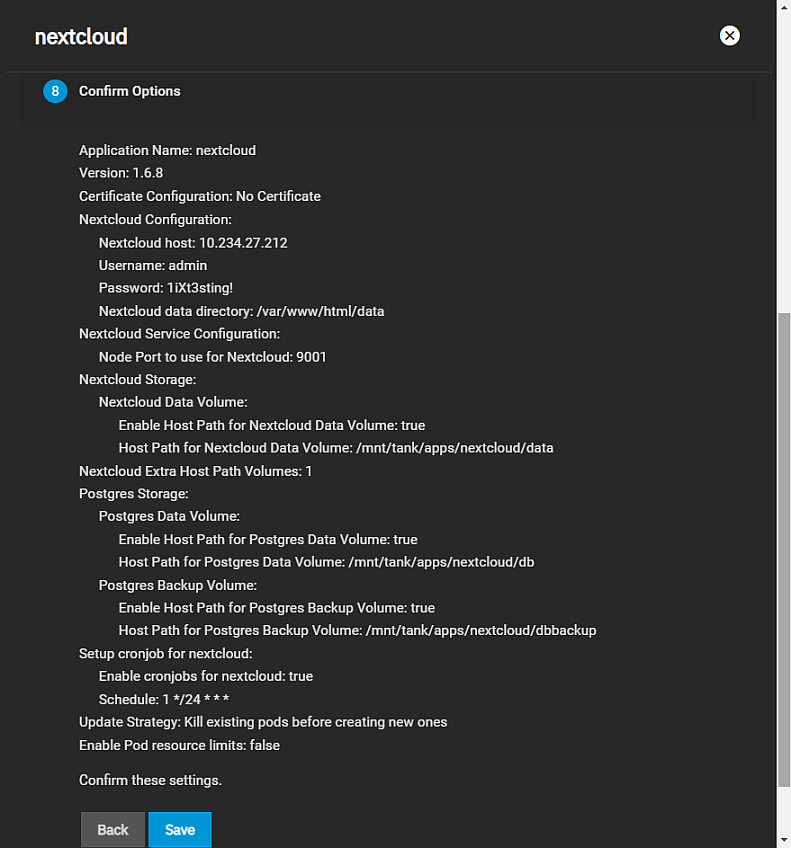
-
Click on the Installed Applications tab to see the nextcloud widget.

When the nextcloud widget displays ACTIVE, click Web Portal to open the NextCloud sign in screen in a new browser window.
